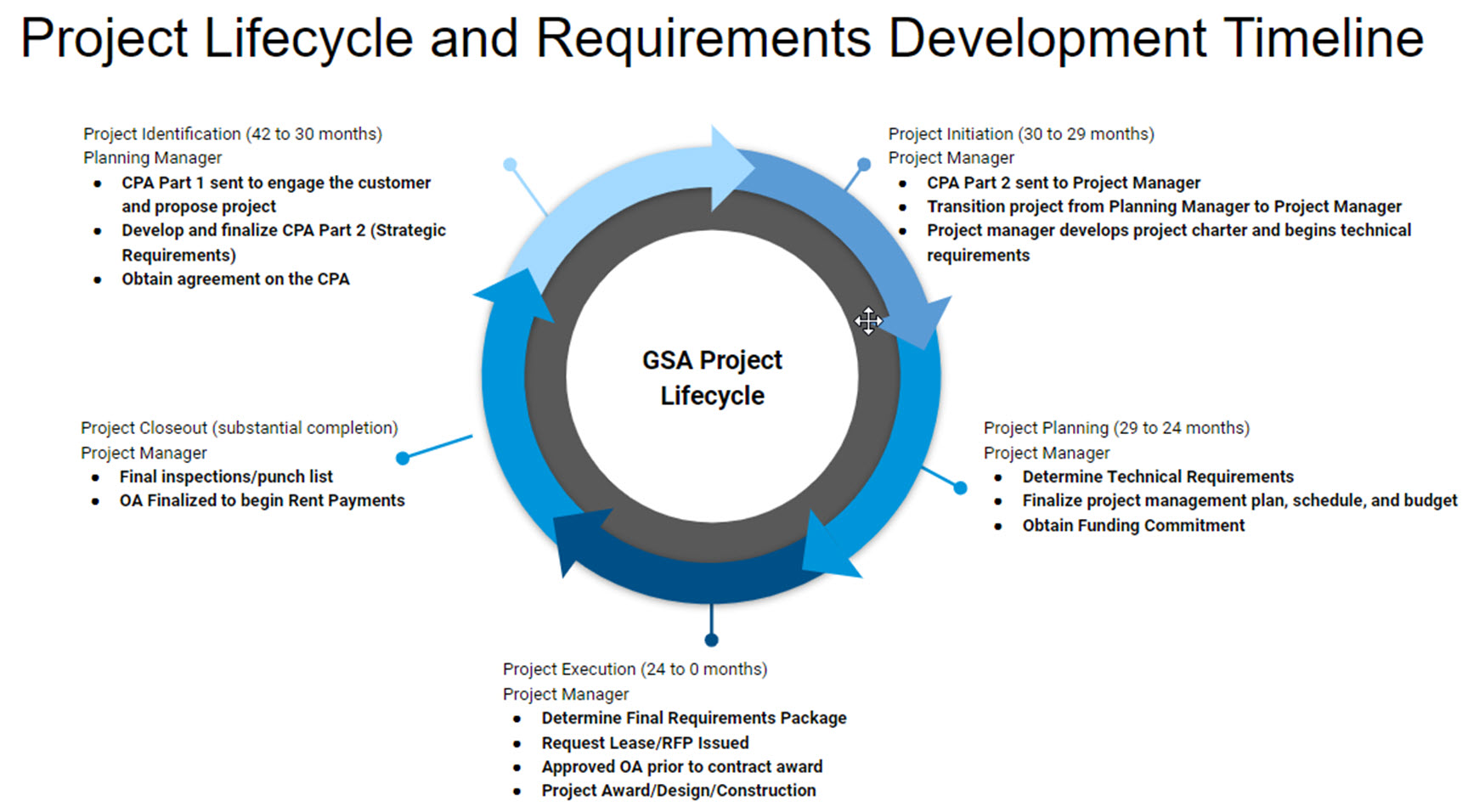The PBS occupancy planning process standardizes milestone dates, requirements terminology, and responsibilities as customer agency Occupancy Agreements (OA) approach expiration.
Following the planning process is critical to achieving PBS and our customers’ mutual goals of:
- Reducing spending
- Reducing space and overall footprint
- Increasing space utilization
Occupancy planning and requirements gathering topics
Client project agreement
The Client Project Agreement is a collaborative document that defines a project’s strategic requirements and other occupancy considerations. The CPA Part 1 includes your current occupancy information and provides GSA’s proposed strategy based on known information. Once we collaborate on your strategic requirements, we will outline the project parameters and obtain agreement in the CPA Part 2. Signature on the CPA indicates consensus on the project’s strategic requirements. Next, a project team is assigned to develop technical requirements.
To learn more about the CPA you can view Part 1 and Part 2.
Requirements definitions
Strategic requirements represent high level information that establishes basic project parameters. This information includes existing occupancy information, total square feet, approximate headcount, location, use of space, parking, and utilization rate for the follow on project. Identifying strategic requirements on time is critical to a project’s overall success.
Functional requirements are developed from the strategic requirements by the GSA Project Manager and project team. This refined data set defines the new space’s parameters, operations, expectations, schedule, and cost goals. Functional requirements include, but are not limited to, a verified total square footage, headcount, and geographic location. The Project Manager reviews the functional requirements and the initial project management plan/schedule with the customer at the project kick-off meeting.
Technical requirements refine the strategic requirements into the specific details needed to deliver the project. Technical requirements include agency-specific requirements, agency-specific security information, basic space plans and adjacency plans. This is the final step in the requirements-gathering process before a Request for Lease Proposals (RLP) can be issued or a construction project can begin in owned locations. These details will inform the Project Management Plan. Note: Initial schedule, costs, and an OA will be shared prior to lease award.
Project lifecycle and milestones
(milestone dates are for non-prospectus projects. Prospectus project milestones noted separately)
Identification phase - 36-30 prior to OA expiration*
18-12 months prior to OMB submission (prospectus projects)
- PBS point of contact**: Regional Planning Manager
- Activities
- Determine strategic requirements
- Sign client project agreement***
Initiation phase - 30-29 months prior to OA expiration
12-11 months prior to OMB submission (prospectus projects)
- PBS point of contact: Regional Planning Manager
- Activities
- Assign project manager
- Project team kick off
- Develop preliminary schedule
Planning phase - 29-24 months prior to OA expiration
53-36 months prior to OA expiration (aligns with CILP+ date)++ (prospectus projects)
- PBS point of contact: Project manager
- Activities
- Determine technical requirements
- Finalize project management plan, schedule, and budget
- Obtain funding commitment
Execution phase - 24-0 months prior to OA expiration
36-0 months prior to OA expiration+++ (prospectus projects)
- PBS point of contact: Project manager
- Activities
- Determine final requirements package
- Request lease/RFP issued
- Draft OA approved
- Project award
- Design
- Construction
Close out phase - substantial completion
- PBS point of contact: Project manager
- Activities
- Final inspections
- Punch list
- OA finalized to begin rent payments
* In some cases, factors beyond expiration can trigger engagement and strategic requirements development.
** Certain PBS personnel, such as the Lease Contracting Officer, will remain involved at multiple phases
*** Or other form of written documentation showing acceptance of the strategy in the CPA
+ Capital Investment and Leasing Program Prospectus (CILP)
++ Once strategic requirements are identified, project manager secures technical requirements over next 24 months
+++ Typical duration, actual schedule may vary
Training and resources

 U.S. General Services Administration
U.S. General Services Administration
